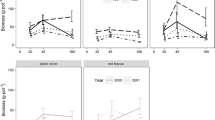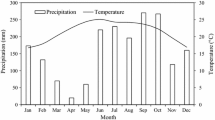Abstract
From a series of shade tolerance screening trials conducted in an outdoor Shade Tolerance Screening Laboratory, 22 forages (16 grasses and 6 legumes) were selected for quality evaluation. The forages were grown under non-shade (100% of full sun, the control), moderate shade (45%), and dense shade (20%) with adequate water and nutrients and free of competition from other plants. All 22 forages had equal or higher percent crude protein (%CP) and CP yield (g pot−1) under moderate shade than in the control. Under dense shade, 22 and 18 forages had equal or higher %CP and CP yield than in the control, respectively. Under moderate and dense shade, 14 and 15 forages, respectively, maintained relative feed value (RFV) equal to that in the control. Legumes had higher %CP and RFV than grasses with no differences for CP yield. Relative distance plasticity index (RDPI), an indicator of a species’ adaptability to different environments, suggested grasses maintained RFV better than legumes under shade, while legumes were more resilient under shade in maintaining %CP than grasses. Our results suggest most grass and legume forages will maintain or have improved quality when grown in agroforestry practices with light to moderate shade compared to forages grown in open pastures.




Similar content being viewed by others
References
Abraham EM, Kyriazopoulos AP, Parissi ZM, Kostopoulou P, Karatassiou M, Anjalanidou K, Katsouta C (2014) Growth, dry matter production, phenotypic plasticity, and nutritive value of three natural populations of Dactylis glomerata L. under various shading treatments. Agrofor Syst 88:287–299. doi:10.1007/s10457-014-9682-9
Allard G, Nelson CJ, Pallardy SG (1991) Shade effects on growth of tall fescue: I. leaf anatomy and dry matter partitioning. Crop Sci 31:163–167. doi:10.2135/cropsci1991.0011183X003100010037x
Ball DM, Collins M, Lacefield GD, Martin NP, Mertens DA, Olson KE, Putnam DH, Undersander DJ, Wolf MW (2001) Understanding forage quality. American Farm Bureau Federation, Park Ridge
Bonin CL, Tracy BF (2011) Forage yield, nutritive value, and elemental composition of ten native prairie plant species. Forage Grazinglands. doi:10.1094/FG-2011-1103-01-RS
Burton GW, Jackson JE, Knox FE (1959) The influence of light reduction upon the production, persistence and chemical composition of coastal bermudagrass, Cynodon dactylon. Agron J 51:537–542. doi:10.2134/agronj1959.00021962005100090009x
Callaway R (2007) Positive interactions and interdependence in plant communities. Springer, Dordrecht
Chabot BF, Chabot JF (1977) Effects of light and temperature on leaf anatomy and photosynthesis in Fragaria vesca. Oecologia 26:363–377. doi:10.1007/BF00345535
Contreras-Govea FE, Albrecht KA (2006) Forage production and nutritive value of oat in autumn and early summer. Crop Sci 46:2382–2386. doi:10.2135/cropsci2005.12.0458
Del Pozo A, Garnier E, Aronson J (2000) Contrasted nitrogen utilization in annual C3 grass and legume crops: physiological explorations and ecological considerations. Acta Oecol 21:79–89. doi:10.1016/S1146-609X(00)00113-2
Garrett HE, Kurtz WB (1983) Silvicultural and economic relationships of integrated forestry-farming with black walnut. Agrofor Syst 1:245–256
Hancock DW, Saha U, Stewart Jr., RL, Bernard JK, Smith III, RC, Johnson JM (2014) Understanding and improving forage quality. The University of Georgia, Cooperative Extension. http://extension.uga.edu/publications/detail.cfm?number=B1425
Henning JC, Lacefield GD, Amaral-Phillips D (1991) Interpreting forage quality reports. Cooperative Extension Service, University of Kentucky. http://www2.ca.uky.edu/agcomm/pubs/id/id101/id101.pdf
Hight GK, Sinclair DP, Lancaster RJ (1968) Some effects of shading and of nitrogen fertiliser on the chemical composition of freeze-dried and oven-dried herbage, and on the nutritive value of oven-dried herbage fed to sheep. N Z J Agric Res 11:286–302. doi:10.1080/00288233.1968.10431428
Houx JH, McGraw RL, Fritschi FB, Navarrete-Tindall NE (2009) Effects of shade on growth and nodulation of three native legumes with potential for use in agroforestry. Native Plants J 10:232–238
Jeranyama P, Garcia AD (2004) Understanding relative feed value (RFV) and relative forage quality (RFQ). South Dakota State University. http://agbiopubs.sdstate.edu/articles/ExEx8149.pdf
Kallenbach RL, Kerley MS, Bishop-Hurley GJ (2006) Cumulative forage production, forage quality and livestock performance from an annual ryegrass and cereal rye mixture in a pine walnut silvopasture. Agrofor Syst 66:43–53. doi:10.1007/s10457-005-6640-6
Kyriazopoulos AP, Abraham EM, Parissi ZM, Koukoura Z, Nastis AS (2013) Forage production and nutritive value of Dactylis glomerata and Trifolium subterraneum mixtures under different shading treatments. Grass Forage Sci 68:72–82. doi:10.1111/j.1365-2494.2012.00870.x
Lin CH, McGraw RL, George MF, Garrett HE (1999) Shade effects on forage crops with potential in temperate agroforestry practices. Agrofor Syst 44:109–119. doi:10.1023/A:1006205116354
Lin CH, McGraw RL, George MF, Garrett HE (2001) Nutritive quality and morphological development under partial shade of some forage species with agroforestry potential. Agrofor Syst 53:269–281. doi:10.1023/A:1013323409839
Martsolf JD (1966) Microclimatic modification through shade induced changes in net radiation. Ph.D. dissertation, University of Missouri-Columbia
Masuda Y (1977) Comparisons of the in vitro dry matter digestibility of forage oats grown under different temperatures and light intensities. J Fac Agric Kyushu Univ 21:17–24
Norton BW, Wilson JR, Shelton HM, Hill KD (1991) The effect of shade on forage quality. Forages Plant Crops Camberra 32:83
Pang K, Van Sambeek JW, Navarrete-Tindall NE, Lin CH, Jose S, Garrett HE (2017) Responses of legumes and grasses to non-, moderate, and dense shade in Missouri, USA. I. Forage yield and its species-level plasticity. Agrofor Syst. doi:10.1007/s10457-017-0067-8
Peri PL, Lucas RJ, Moot DJ (2007) Dry matter production, morphology and nutritive value of Dactylis glomerata growing under different light regimes. Agrofor Syst 70:63–79. doi:10.1007/s10457-007-9029-x
Redfearn D, Zhang H, Caddel J (2010) Forage quality interpretations. Oklahoma Cooperative Extension Service, Oklahoma
Reid RL, Jung GA, Allison DW (1988) Nutrition quality of warm season grasses in the Northeast. West Virginia Agriculture and Forestry Experiment Station, Morgantown
Rivera JD, Parish JA (2010) Interpreting forage and feed analysis reports. Mississippi State University Extension Service, Mississippi
Saha UK, Sonon LS, Hancock DW, Hancock DW, Hill NS, Stewart L, Heusner GL, Kissel DE (2010) Common terms used in animal feeding and nutrition. The University of Georgia, Cooperative Extension
Samarakoon SP (1988) The effects of shade on quality, dry matter yield and nitrogen economy of Stenotaphrum secundatum compared with Axonopus compressus and Pennisetum clandestinum. Master thesis, University of Queensland
Samarakoon SP, Wilson JR, Shelton HM (1990) Growth, morphology and nutritive quality of shaded Stenotaphrum secundatum, Axonopus compressus and Pennisetum clandestinum. J Agric Sci 114:161–169. doi:10.1017/S0021859600072154
USDA NRCS. 2016. The PLANTS Database. National Plant Data Team, Greensboro. http://plants.usda.gov. Accessed 25 Apr 2016
Valladares F, Sanchez-Gomez D, Zavala MA (2006) Quantitative estimation of phenotypic plasticity: bridging the gap between the evolutionary concept and its ecological applications. J Ecol 94:1103–1116. doi:10.1111/j.1365-2745.2006.01176.x
Wong C, Wilson J (1980) Effects of shading on the growth and nitrogen content of green panic and Siratro in pure and mixed swards defoliated at two frequencies. Aust J Agric Res 31:269–285
Acknowledgements
This work was funded by the University of Missouri Center for Agroforestry under cooperative agreement AG-02100251 with the USDA—ARS Dale Bumpers Small Farm Research Center, Booneville, AR, and CR 826704-01-0 with the US EPA. We want to express our appreciation to the HARC staff, especially Steve Kirk for maintaining the studies in the STSL and harvesting the forages. Others include Robert McGraw, our retired agronomist, Marissa Huck for chemical analyses to determine forage quality, and John Stanovick, USDA FS statistician.
Author information
Authors and Affiliations
Corresponding author
Electronic supplementary material
Below is the link to the electronic supplementary material.
Rights and permissions
About this article
Cite this article
Pang, K., Van Sambeek, J.W., Navarrete-Tindall, N.E. et al. Responses of legumes and grasses to non-, moderate, and dense shade in Missouri, USA. II. Forage quality and its species-level plasticity. Agroforest Syst 93, 25–38 (2019). https://doi.org/10.1007/s10457-017-0068-7
Received:
Accepted:
Published:
Issue Date:
DOI: https://doi.org/10.1007/s10457-017-0068-7




